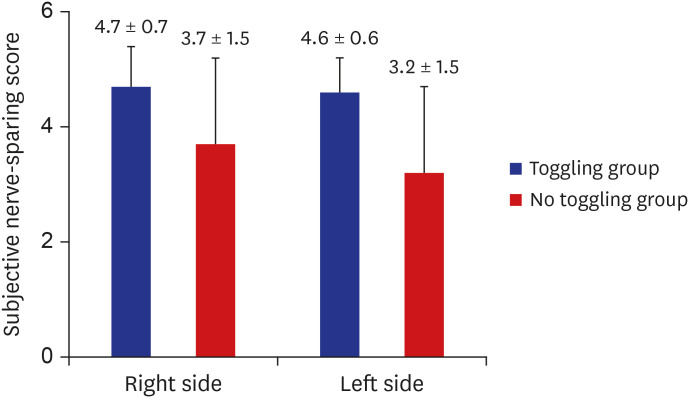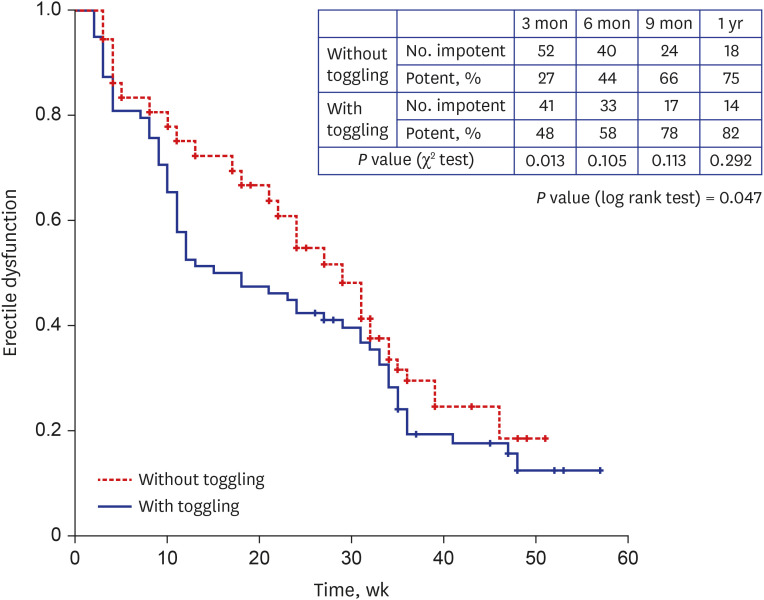J Korean Med Sci.
2022 Jan;37(1):e6. 10.3346/jkms.2022.37.e6.
Toggling Technique Allows Retrograde Early Release to Facilitate Neurovascular Bundle Sparing During Robot-Assisted Radical Prostatectomy: A Propensity ScoreMatching Study
- Affiliations
-
- 1Department of Urology, Anam Hospital, Korea University College of Medicine, Seoul, Korea
- 2Global Robotics Institute, Florida Hospital-Celebration Health Celebration, University of Central Florida School of Medicine, Orlando, FL, USA
- KMID: 2524183
- DOI: http://doi.org/10.3346/jkms.2022.37.e6
Abstract
- Background
This study aimed to present the surgical facilitation of neurovascular bundle (NVB) sparing using the toggling technique (30° lens down/up switching) and to evaluate erectile dysfunction (ED) recovery after robot-assisted radical prostatectomy (RARP).
Methods
We assessed 144 patients (group with toggling, n = 72; group without toggling, n = 72) who underwent RARP with bilateral NVB sparing using propensity score matching. Inclusion criteria were ≥ 1 year follow-up and preoperative potency as per the Sexual Health Inventory for Men (SHIM) questionnaire (≥ 17 points). Recovery of ED after RARP was defined as return to baseline sexual function or self-assessment regarding successful intercourse. The subjective surgeon’s nerve sparing (SNS) score and tunneling success rates were used to evaluate surgical facilitation. The recovery rate of ED between the groups was analyzed using Kaplan-Meier analysis.
Results
A better ED recovery trend was confirmed according to the SNS score (R 2 = 0.142, P = 0.004). In the analysis of NVB sparing ease, the toggling group showed higher SNS scores (on right/left side: P = 0.011 and < 0.001, respectively) and overall tunneling success rates (87% vs. 74%, P = 0.001) than the group without toggling. Overall, ED recovery rates were 82% (59/72) and 75% (54/72) in the groups with and without toggling, respectively, at the 1-year follow-up (P = 0.047), and the toggling group showed a faster ED recovery rate at 3 months (47% vs. 35%, P = 0.013). In a specific analysis of the potent cohort (< 60 years, bilateral full NVB spared, SHIM score ≥ 22), the ED recovery rate reached 87% (14/16) in the toggling group.
Conclusion
The retrograde early release with the toggling technique improves the facilitation of NVB sparing, leading to improved ED recovery.
Figure
Reference
-
1. Coughlin GD, Yaxley JW, Chambers SK, Occhipinti S, Samaratunga H, Zajdlewicz L, et al. Robot-assisted laparoscopic prostatectomy versus open radical retropubic prostatectomy: 24-month outcomes from a randomised controlled study. Lancet Oncol. 2018; 19(8):1051–1060. PMID: 30017351.
Article2. de Carvalho PA, Barbosa JABA, Guglielmetti GB, Cordeiro MD, Rocco B, Nahas WC, et al. Retrograde release of the neurovascular bundle with preservation of dorsal venous complex during robot-assisted radical prostatectomy: optimizing functional outcomes. Eur Urol. 2020; 77(5):628–635. PMID: 30041833.
Article3. Finley DS, Rodriguez E Jr, Skarecky DW, Ahlering TE. Quantitative and qualitative analysis of the recovery of potency after radical prostatectomy: effect of unilateral vs bilateral nerve sparing. BJU Int. 2009; 104(10):1484–1489. PMID: 19388985.
Article4. Hakimi AA, Blitstein J, Feder M, Shapiro E, Ghavamian R. Direct comparison of surgical and functional outcomes of robotic-assisted versus pure laparoscopic radical prostatectomy: single-surgeon experience. Urology. 2009; 73(1):119–123. PMID: 18952268.
Article5. Menon M, Dalela D, Jamil M, Diaz M, Tallman C, Abdollah F, et al. Functional recovery, oncologic outcomes and postoperative complications after robot-assisted radical prostatectomy: an evidence-based analysis comparing the Retzius sparing and standard approaches. J Urol. 2018; 199(5):1210–1217. PMID: 29225060.
Article6. Patel VR, Coelho RF, Chauhan S, Orvieto MA, Palmer KJ, Rocco B, et al. Continence, potency and oncological outcomes after robotic-assisted radical prostatectomy: early trifecta results of a high-volume surgeon. BJU Int. 2010; 106(5):696–702. PMID: 20707793.
Article7. Sooriakumaran P, Pini G, Nyberg T, Derogar M, Carlsson S, Stranne J, et al. Erectile function and oncologic outcomes following open retropubic and robot-assisted radical prostatectomy: results from the LAParoscopic Prostatectomy Robot Open Trial. Eur Urol. 2018; 73(4):618–627. PMID: 28882327.
Article8. Zorn KC, Gofrit ON, Steinberg GP, Taxy JB, Zagaja GP, Shalhav AL. Planned nerve preservation to reduce positive surgical margins during robot-assisted laparoscopic radical prostatectomy. J Endourol. 2008; 22(6):1303–1309. PMID: 18484875.
Article9. Kowalczyk KJ, Huang AC, Hevelone ND, Lipsitz SR, Yu HY, Ulmer WD, et al. Stepwise approach for nerve sparing without countertraction during robot-assisted radical prostatectomy: technique and outcomes. Eur Urol. 2011; 60(3):536–547. PMID: 21620561.
Article10. Mulhall JP, Slovick R, Hotaling J, Aviv N, Valenzuela R, Waters WB, et al. Erectile dysfunction after radical prostatectomy: hemodynamic profiles and their correlation with the recovery of erectile function. J Urol. 2002; 167(3):1371–1375. PMID: 11832735.
Article11. Tewari A, Rao S, Martinez-Salamanca JI, Leung R, Ramanathan R, Mandhani A, et al. Cancer control and the preservation of neurovascular tissue: how to meet competing goals during robotic radical prostatectomy. BJU Int. 2008; 101(8):1013–1018. PMID: 18261153.
Article12. Walsh PC. Anatomic radical prostatectomy: evolution of the surgical technique. J Urol. 1998; 160(6 Pt 2):2418–2424. PMID: 9817395.13. Ficarra V, Cavalleri S, Novara G, Aragona M, Artibani W. Evidence from robot-assisted laparoscopic radical prostatectomy: a systematic review. Eur Urol. 2007; 51(1):45–55. PMID: 16854519.
Article14. Schatloff O, Chauhan S, Sivaraman A, Kameh D, Palmer KJ, Patel VR. Anatomic grading of nerve sparing during robot-assisted radical prostatectomy. Eur Urol. 2012; 61(4):796–802. PMID: 22230713.
Article15. Tewari AK, Srivastava A, Huang MW, Robinson BD, Shevchuk MM, Durand M, et al. Anatomical grades of nerve sparing: a risk-stratified approach to neural-hammock sparing during robot-assisted radical prostatectomy (RARP). BJU Int. 2011; 108(6 Pt 2):984–992. PMID: 21917101.
Article16. Kang SG, Shim JS, Onol F, Bhat KRS, Patel VR. Lessons learned from 12,000 robotic radical prostatectomies: is the journey as important as the outcome? Investig Clin Urol. 2020; 61(1):1–10.
Article17. Coughlin G, Dangle PP, Palmer KJ, Samevedi S, Patel VR. Athermal early retrograde release of the neurovascular bundle during nerve-sparing robotic-assisted laparoscopic radical prostatectomy. J Robot Surg. 2009; 3(1):13–17. PMID: 27628447.
Article18. Patel VR, Coelho RF, Palmer KJ, Rocco B. Periurethral suspension stitch during robot-assisted laparoscopic radical prostatectomy: description of the technique and continence outcomes. Eur Urol. 2009; 56(3):472–478. PMID: 19560260.
Article19. Kang SG, Schatloff O, Haidar AM, Samavedi S, Palmer KJ, Cheon J, et al. Does surgeon subjective nerve sparing score predict recovery time of erectile function following robot-assisted radical prostatectomy? J Sex Med. 2015; 12(6):1490–1496. PMID: 25689342.
Article20. Dubbelman YD, Dohle GR, Schröder FH. Sexual function before and after radical retropubic prostatectomy: a systematic review of prognostic indicators for a successful outcome. Eur Urol. 2006; 50(4):711–718. PMID: 16846679.
Article21. Levinson AW, Pavlovich CP, Ward NT, Link RE, Mettee LZ, Su LM. Association of surgeon subjective characterization of nerve sparing quality with potency following laparoscopic radical prostatectomy. J Urol. 2008; 179(4):1510–1514. PMID: 18295270.
Article22. Michl UH, Friedrich MG, Graefen M, Haese A, Heinzer H, Huland H. Prediction of postoperative sexual function after nerve sparing radical retropubic prostatectomy. J Urol. 2006; 176(1):227–231. PMID: 16753406.
Article23. van der Poel HG, de Blok W. Role of extent of fascia preservation and erectile function after robot-assisted laparoscopic prostatectomy. Urology. 2009; 73(4):816–821. PMID: 19195692.
Article24. Finley DS, Osann K, Skarecky D, Ahlering TE. Hypothermic nerve-sparing radical prostatectomy: rationale, feasibility, and effect on early continence. Urology. 2009; 73(4):691–696. PMID: 19250660.
Article
- Full Text Links
- Actions
-
Cited
- CITED
-
- Close
- Share
- Similar articles
-
- Nerve-sparing techniques and results in robot-assisted radical prostatectomy
- Initial experience with Retzius-sparing robot-assisted radical prostatectomy compared to the conventional method: is it a suitable option for robotic prostatectomy beginners?
- Simultaneous Robot-Assisted Laparoendoscopic Single-Site Partial Nephrectomy and Standard Radical Prostatectomy
- Erratum: Robot-Assisted Laparoscopic Radical Prostatectomy
- Standardized 4-step technique of bladder neck dissection during robot-assisted radical prostatectomy




